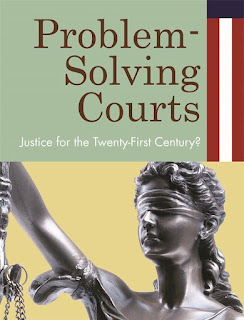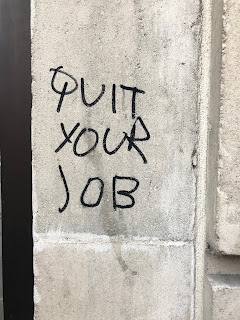Problems With "The Problem of Problem-Solving Courts"
Last week, a new article on problem-solving courts came across my radar. Written by Erin R. Collins, a professor at the University of Richmond School of Law, “The Problem of Problem-Solving Courts,” attempts a revisionist history of problem-solving justice. As I read it, Collins makes three principal arguments against problem-solving
courts:
1. “Problem-solving courts also emerged to solve
a problem internal to the judicial process itself: a growing sense of judicial
dissatisfaction and disempowerment caused by the rise of structured and
mandatory sentencing schemes.”
Collins claims (with no empirical evidence) that,
essentially, judges across the United States came to feel powerless as a result
of sentencing schemes that limited their discretion and have sought to use problem-solving
courts to increase their authority.
Despite the lack of supporting data, it is of course possible
that mandatory sentencing laws may have been a factor in the rise of problem-solving
courts. But, to paraphrase Inigo Montoya from The Princess Bride, this doesn’t
mean what Collins thinks it means.
Collins seems to think that this is a damning indictment of
problem-solving courts. It is not. Rather, it is an indication of why they are
an important reform movement.
Problem-solving courts first emerged more than 25 years ago
in a political moment very different from the one that we currently
occupy. This was an era where “tough on
crime” rhetoric and policymaking were ascendant. Criminal justice legislation at the state and
federal level tended toward strengthening penalties for wrong-doing – mandatory
minimums, three-strikes-and-you’re-out, and other such laws.
Problem-solving courts were a response to this reality. In a hostile political environment, they
sought to push the justice system away from strictly punitive responses to
criminal behavior and toward more rehabilitative sentencing outcomes. They also encouraged justice system actors
(not just judges but attorneys and clerks and court officers) to see defendants
as individuals worthy of being treated with dignity and respect.
In the process, problem-solving courts recalibrated the
balance of power in the courtroom. The sentencing reforms of the preceding
years had tilted the playing field in the direction of prosecutors – their
charging decisions and sentencing recommendations largely dictated how a case
would proceed for defendants who were facing the threat of long spells behind
bars. By restoring a measure of judicial
discretion, problem-solving courts have helped to improve fairness in the
justice system, allowing thousands of defendants to avoid harsh sentences. They also provided a framework that
encouraged prosecutors to step back from maximalist and retributive approaches
to justice. This helped set the stage for the progressive prosecution movement
that has emerged over the past several years.
In her effort to make the case for the importance of
judicial discretion as an underlying driver of the problem-solving court
movement, Collins gives short shrift to a much more obvious force fueling the
expansion of these programs. Judges and
court administrators faced massive spikes in criminal court caseloads in the
1980s. Many understandably sought new
ways to solve the problems that were fueling the influx of cases. They gravitated
toward programs like drug court and mental health court not because they were petty
bureaucrats seeking to expand their power but because they were reformers seeking
to solve the real-life problems of court users.
And they did this in the face of powerful countervailing winds,
including the widespread idea that “nothing works” to change the behavior of
offenders. Indeed, the success of problem-solving
courts has arguably helped to change this dynamic, making it clear that criminal
justice interventions can succeed in reducing crime.
2.“the
actual data on [problem-solving courts] efficacy is underwhelming,
inconclusive, or altogether lacking”
Collins seems to long for a world in which new reforms are
rigorously tested in experimental settings before being replicated in other
places and where researchers render clear judgments as to whether the programs
work or not. I sometimes pine for this ideal
world myself, but it is not alas the world in which we live.
In my experience, research findings are always mixed. Researchers almost never deliver categorical
judgments, either positive or negative, about social interventions. It is fair to say that the research
literature does not speak unequivocally about problem-solving courts. There are studies that have documented
negative impacts. There is still much we
don’t know. There is always a need for
more research. (There is also a need for
discipline and modesty among advocates of problem-solving justice, who have sometimes
over-stated the impact of their programs.)
Reasonable people can disagree about how to interpret research
findings. Collins finds the literature
on problem-solving courts underwhelming.
I find it pretty convincing. I
base my conclusion on sources like the following:
- A review of 150 (!) drug court evaluations finds that “research has amply demonstrated the positive impact of adult drug courts on re-offending… an array of cost-benefit studies almost universally confirm that drug courts save money.” (Rempel, M. (2014). “Drug Courts.” pp. 1159-1170 in Encyclopedia of Criminology and Criminal Justice, eds. G. Bruinsma & D. Weisburd. New York, NY: Springer.
- A review of 17 studies of mental health courts (involving more than 16,000 participants) concluded that “our finding supports the effectiveness of mental health courts in reducing recidivism.”
Of course, recidivism is not the only measure that matters. Beyond recidivism, problem-solving courts
have been documented to achieve a range of other positive outcomes. This includes improving perceptions of
justice, both among defendants and among community residents. In a moment when the justice system is suffering from a crisis of legitimacy in
many quarters, problem-solving courts offer potentially valuable lessons about
how to promote public trust in justice. And
many (but not all) problem-solving courts have reduced the use of incarceration
as well.
In the end, the most honest, bottom-line assessment of
problem-solving courts is probably this one: “Problem-solving courts are not
silver bullets. The impact they have on reoffending is positive but also
modest, like any other evidence-based intervention."
The research about problem-solving courts may not blow
Collins away, but it is robust when measured against other criminal justice
programs. Here we would be wise to remember
the late Joan Petersilia’s cautionary note:
There’s
nothing in our history of over 100 years of reform that says that we know how
to reduce recidivism by more than 15 or 20 percent. And to achieve those rather
modest outcomes, you have to get everything right – the right staff, delivering
the right program, at the right time in the offender’s life, and in a
supportive community environment. We just have to be more honest about that.
(Indeed, there is more research to document the effectiveness
of problem-solving courts than there is for diversion programs, pretrial
supervised release programs, and credible messenger programs, to mention just
three reforms that are being broadly replicated at the moment.)
3. “[The] belief that problem-solving courts
are the most effective reform strategy is problematic not only because it is
inaccurate, but also because it can create resistance to alternative reforms.”
Collins argues that problem-solving courts are standing in
the way of other, more fundamental reforms.
In New York, something like the opposite has been the case – problem-solving
courts have been the foundation upon which other reforms have been built. Two examples are worth highlighting in this
regard.
For decades, criminal justice advocates sought to reform New
York’s Rockefeller Drug Laws, which mandated long prison terms for those convicted
of drug offenses, without success. When change finally happened, in 2009, government
decisionmakers cited the impact of New York’s drug courts as one of the justifications
for passing new legislation. Indeed, the
legislation that passed explicitly sought to expand judicial discretion to
offer drug court alternatives to a broader range of defendants.
More recently, the New York City Council approved a plan to
close the notorious jail complex on Rikers Island. This systemic reform was only conceivable because
problem-solving courts had helped to change the culture within the local justice
system. According to the New York Times:
Fewer
inmates are behind bars in New York on any given day than at any time in the
past 24 years…While the plunge in the city’s crime rate has undoubtedly been a
critical factor, a number of other large cities where crime has also fallen
have not seen a parallel drop in their jail population. Instead, steps taken by
the city, including special courts to deal with nonviolent offenders and
programs to deter former convicts from returning to jail, appear to be bearing
fruit…New special community courts in Midtown Manhattan, Brooklyn, Harlem and
the Bronx as well as drug courts and mental health courts, are meting out
alternative sentences like street cleaning or drug treatment instead of jail
time.
Within the justice system, problem-solving courts helped
shift the attitudes of judges and prosecutors iabout sentencing and interactions
with defendants. Outside of the system,
problem-solving courts have demonstrated to the public that alternatives to
incarceration can achieve positive public safety outcomes, in turn making it
politically acceptable to support policies that promote rehabilitation and decarceration.
Problem-solving courts have made an important contribution
to criminal justice reform in the United States. During decades in which it was politically impossible
to advance any kind of legislative change that was not focused on strengthening
penalties, problem-solving courts managed to introduce significant change
within one of our most conservative (with a small “c”) institutions: the
courts. They demonstrated that the walls
would not cave in if we treated defendants and victims alike with humanity and
decency. They also helped make the case
that it is possible to change the behavior of offending populations during an
era when the very idea of rehabilitation was widely discredited. In sum, we can only imagine the systemic
reforms that are currently being advanced because of the success of problem-solving
courts.
The challenge now confronting problem-solving courts is how
to adapt to a world that they helped to create. If “regular” courts begin to look more and
more like problem-solving courts, how will problem-solving courts evolve? This is where Collins’ article is
helpful. To continue to make a positive contribution
to criminal justice reform, problem-solving courts must be committed to rigorous
self-reflection and continuous self-improvement. Reading and engaging with thoughtful critics
like Collins is essential to the long-term health of problem-solving justice.

